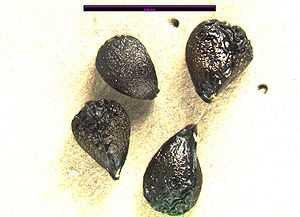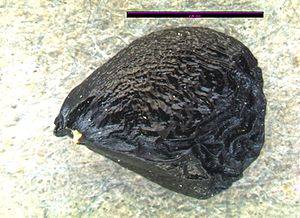Difference between revisions of "Camassia leichtlinii"
| Line 18: | Line 18: | ||
| − | Habitat- Vernally moist meadows in the lowland zone <ref>Douglas et al., 2001.</ref>. Grassy slopes and meadows <ref>(Pojar and Mackinnon, 1994)</ref>.Nutrients-Nitrogen-rich soils. Moder and Mull humus <ref> | + | Habitat- Vernally moist meadows in the lowland zone <ref>Douglas et al., 2001.</ref>. Grassy slopes and meadows <ref>(Pojar and Mackinnon, 1994)</ref>.Nutrients-Nitrogen-rich soils. Moder and Mull humus <ref>Klinka et al., 1989</ref>.Moisture Regime-Dry to moderately moist soils <ref>Klinka et al., 1989</ref>.Shade Tolerance-Shade-intolerant (Klinka et al., 1989). Landscaping-Use in meadows, grassy slopes and banks. Showy bloom with attractive seed heads. Very tough plant for exposed, hot dry sites once established (S. Bastin, pers. comm.). Use in containers or along pond edges (B. Costanzo, pers. comm.). |
Uses | Uses | ||
Revision as of 11:15, 16 April 2012
First overview block
Camassia leichtlinii (Baker) S. Wats. ssp. suksdorfii (Greenm.) Gould Synonyms Liliaceae Large camas, Great camas, Wild Hyacinth
Taxonomy
DESCRIPTION:Perennial herb from a deep, egg-shaped bulb 2-4 cm long; flowering stems 20-100 cm tall, smooth. Basal leaves several to numerous, linear-lanceolate and grass-like, to 60 cm long, 1-2 cm wide, smooth, sheathing at the base, the margins entire; stem leaves lacking. Inflorescence a terminal raceme of five to many, stalked flowers, the stalks 1-4 cm long, spreading in flower, spreading to ascending in fruit; flowers pale to deep blue, rarely white, of six similar, distinct, petal-like segments (tepals), the tepals 20-40 mm long, 5-10 mm wide, twisting together over the ovary when withered; six stamens; one three-chambered pistil. Capsule fruits, egg-shaped to oblong, cross-ridged, 1-2.5 cm long; fruiting stalks often longer than bracts, spreading to ascending, curved in towards stem; seeds several to many, shiny black, 2-4 mm long [1]
Bloom Period
Distribution
Habitat- Vernally moist meadows in the lowland zone [2]. Grassy slopes and meadows [3].Nutrients-Nitrogen-rich soils. Moder and Mull humus [4].Moisture Regime-Dry to moderately moist soils [5].Shade Tolerance-Shade-intolerant (Klinka et al., 1989). Landscaping-Use in meadows, grassy slopes and banks. Showy bloom with attractive seed heads. Very tough plant for exposed, hot dry sites once established (S. Bastin, pers. comm.). Use in containers or along pond edges (B. Costanzo, pers. comm.).
Uses Propagation Photo Gallery
Seed
Abbreviation: CALEI
Seed sample from: 2011
Average Measurement: 3.3 x 2.2 x 2.1
Measurement Range: L: 3 - 3.75, W: 2 - 2.5, D: 1.75 - 2.25
Features
Shape: Seed are narrower at hilum end, rounding off at opposite side. Hilum end ranges from tapered to pointy in shape.
Color: Seeds black, with conspicuous white hilum.
Surface: A wrinkled seam runs from hilum down the length of the seed in most. Seed is glossy, and wrinkled or bumpy.
Latitudinal Cross Section: elliptical ![]()
Longitudinal Cross Section: obovate ![]()
Basic Explanations and Assumptions:
The dimensions for the seeds are length x width x depth. The location of the hilum is used as the base of the seed, and the length is measured from hilum to the opposite apex. Where a style is present, the length is measured from the hilum to the bottom of the style. Width is measured at a right angle to the length at the widest part. Depth is measured at a right angle to the intersection of height and width lines.
Measurements included are the mean average for each measurement of ten separate seeds.
All measurements in millimeters unless otherwise noted.
references & notes
Douglas et al., 2002. Douglas et al., 2001 Pojar and Mackinnon, 1994 Klinka et al., 1989


